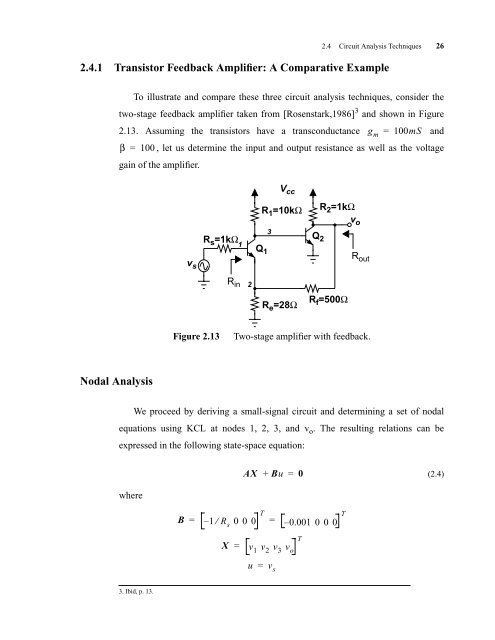- Page 1 and 2: CMOS Optical Preamplifier Design Us
- Page 3 and 4: To achieve low-voltage operation, w
- Page 5 and 6: Table of Contents CHAPTER 1 INTRODU
- Page 7 and 8: CHAPTER 1 1.1 OVERVIEW Introduction
- Page 9 and 10: Information Source Modulator Drive
- Page 11 and 12: 1.2 Thesis Outline 5 [Ohhata,1999].
- Page 13 and 14: 1.2 Thesis Outline 7 technique call
- Page 15 and 16: 1.2 Thesis Outline 9 Detector in St
- Page 17 and 18: E e + - V bias 2.1 Photodetectors 1
- Page 19 and 20: Diode Capacitance (pF) Diode capaci
- Page 21 and 22: 2.2 Optical Preamplifier Structures
- Page 23 and 24: 2.3 Transimpedance Amplifier Design
- Page 25 and 26: 2.3 Transimpedance Amplifier Design
- Page 27 and 28: I dc 2.3 Transimpedance Amplifier D
- Page 29 and 30: 2.3 Transimpedance Amplifier Design
- Page 31: Source Figure 2.11 General structur
- Page 35 and 36: The gain of the forward amplifier c
- Page 37 and 38: Feedback Analysis Using Return Rati
- Page 39 and 40: 2.4 Circuit Analysis Techniques 33
- Page 41 and 42: 2.5 An Overview of Signal-Flow Grap
- Page 43 and 44: 1 x1 x2 2.5 An Overview of Signal-F
- Page 45 and 46: 2.6 SUMMARY REFERENCES • ∆ k =
- Page 47 and 48: Symp. Circuits Systems, vol. 3, pp.
- Page 49 and 50: CHAPTER 3 New Transimpedance Amplif
- Page 51 and 52: 3.1 A Differential Transimpedance A
- Page 53 and 54: 3.1 A Differential Transimpedance A
- Page 55 and 56: 3.1 A Differential Transimpedance A
- Page 57 and 58: 3.2 A Feedback Topology for Ambient
- Page 59 and 60: 3.2 A Feedback Topology for Ambient
- Page 61 and 62: Transimpedance (dBΩ) 90 80 60 40
- Page 63 and 64: 3.3 A Low-Voltage Transimpedance Am
- Page 65 and 66: 3.3 A Low-Voltage Transimpedance Am
- Page 67 and 68: 3.3 A Low-Voltage Transimpedance Am
- Page 69 and 70: 3.3 A Low-Voltage Transimpedance Am
- Page 71 and 72: 3.3 A Low-Voltage Transimpedance Am
- Page 73 and 74: C 3 Φ1VB M 3 V B- =0.7V M 7 Figure
- Page 75 and 76: 3.3 A Low-Voltage Transimpedance Am
- Page 77 and 78: 3.4 SUMMARY 3.4 Summary 71 In this
- Page 79 and 80: 3.4 Summary 73 Y. Nakagome et al.,
- Page 81 and 82: 4.1 Introduction 75 back topology o
- Page 83 and 84:
4.2 Circuit Analysis Using Driving-
- Page 85 and 86:
4.2 Circuit Analysis Using Driving-
- Page 87 and 88:
4.2 Circuit Analysis Using Driving-
- Page 89 and 90:
4.2 Circuit Analysis Using Driving-
- Page 91 and 92:
4.3 DPI/SFG: Combining DPI Analysis
- Page 93 and 94:
4.4 Determining Port Impedances 87
- Page 95 and 96:
v i R in v o R out 4.4 Determining
- Page 97 and 98:
id » ro and 1 ⁄ rid « Av ⁄ ro
- Page 99 and 100:
4.4 Determining Port Impedances 93
- Page 101 and 102:
4.4 Determining Port Impedances 95
- Page 103 and 104:
Z b r e g m 4.5 Analyzing Transisto
- Page 105 and 106:
4.5 Analyzing Transistor Circuits 9
- Page 107 and 108:
Figure 4.25 SFG for the source foll
- Page 109 and 110:
4.5 Analyzing Transistor Circuits 1
- Page 111 and 112:
4.5 Analyzing Transistor Circuits 1
- Page 113 and 114:
4.5 Analyzing Transistor Circuits 1
- Page 115 and 116:
5.1 Analysis of the Low-Voltage Tra
- Page 117 and 118:
5.1 Analysis of the Low-Voltage Tra
- Page 119 and 120:
5.2 DEVELOPING AN ANALYTIC CIRCUIT
- Page 121 and 122:
Z in 5.2 Developing an Analytic Cir
- Page 123 and 124:
5.2 Developing an Analytic Circuit
- Page 125 and 126:
I n1 : i in I n2 -I n1 i scin ( sCi
- Page 127 and 128:
5.2 Developing an Analytic Circuit
- Page 129 and 130:
I nRf : 5.2 Developing an Analytic
- Page 131 and 132:
DC transimpedance gain: Pole locati
- Page 133 and 134:
Frequency (MHz) 500 450 400 350 300
- Page 135 and 136:
Pole frequencies(MHz) 500 450 400 3
- Page 137 and 138:
Optimizing Sensitivity 5.2 Developi
- Page 139 and 140:
5.2 Developing an Analytic Circuit
- Page 141 and 142:
Transimpedance Volts dB (lin) Gain
- Page 143 and 144:
CHAPTER 6 Implementation and Experi
- Page 145 and 146:
6.1 A 1V Optical Receiver Front-End
- Page 147 and 148:
6.1 A 1V Optical Receiver Front-End
- Page 149 and 150:
6.1.2 Experimental Results 6.1 A 1V
- Page 151 and 152:
Gain(dB) 0 −1 −2 −3 −4 −5
- Page 153 and 154:
6.1 A 1V Optical Receiver Front-End
- Page 155 and 156:
6.1 A 1V Optical Receiver Front-End
- Page 157 and 158:
6.1 A 1V Optical Receiver Front-End
- Page 159 and 160:
Clock signal of voltage doubler Eye
- Page 161 and 162:
6.2 Variable-Gain Transimpedance Am
- Page 163 and 164:
6.2.2 Experimental Results 6.2 Vari
- Page 165 and 166:
6.3 Summary and State-of-the-Art Co
- Page 167 and 168:
Reference Outputs Technology Supply
- Page 169 and 170:
CHAPTER 7 Conclusions 7.1 SUMMARY A
- Page 171 and 172:
7.2 Future Work 165 The significanc
- Page 173 and 174:
7.2 Future Work 167 supply and subs
- Page 175 and 176:
v s i ti that part of the SFG for Q
- Page 177 and 178:
Thus, P1 ′ = b = 500Ω ∆1 ′
- Page 179 and 180:
itive representation of circuit dyn
- Page 181 and 182:
Bipolar Transistor i scb Z b v b b














